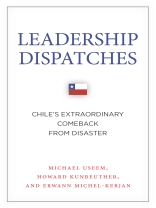On February 27, 2010, Chile was rocked by a violent earthquake five hundred times more powerful than the one that hit Haiti just six weeks prior. The Chilean earthquake devastated schools, hospitals, roads, and homes, paralyzing the country for weeks and causing economic damage that was equal to 18 percent of Chile’s GDP. This calamity hit just as an incumbent political regime was packing its bags and a new administration was preparing to take office. For most countries, it would have taken years, if not decades, to recover from such an event. Yet, only one year later, Chile’s economy had reached a six percent annual growth rate.
In Leadership Dispatches, Michael Useem, Howard Kunreuther, and Erwann Michel-Kerjan look at how the nation’s leaders—in government, business, religion, academia, and beyond—facilitated Chile’s recovery. They attribute Chile’s remarkable comeback to a two-part formula consisting of strong national leadership on the one hand, and deeply rooted institutional practices on the other. Coupled with strategic, deliberative thinking, these levers enabled Chile to bounce back quickly and exceed its prior national performance. The authors make the case that the Chilean story contains lessons for a broad range of organizations and governments the world over.
Large-scale catastrophes of many kinds—from technological meltdowns to disease pandemics—have been on the rise in recent years. Now is the time to seek ideas and guidance from other leaders who have triumphed in the wake of a disaster. In this vein, Leadership Dispatches is both a remarkable story of resilience and an instructive look at how those with the greatest responsibility for a country, company, or community should lead.
Tabela de Conteúdo
Contents and Abstracts
1
Twelve Days Before Entering the Presidential Office
chapter abstract
Chile’s great earthquake of 2010 was the sixth greatest earthquake ever recorded. Chile’s president-elect, Sebastián Piñera, decided to embrace two orders of business, one well in hand from his campaign for the presidency, the other forced by the natural calamity. He would pursue what had been promised before the earthquake – but now also what had been required by the earthquake. In formulating both a near-term plan and long-term strategy for overcoming and then transcending the calamity, the new administration’s actions offer an instructive look at how those with greatest responsibility for a country, company, or community can best attack the extraordinary challenges of coming fully back from calamity and instituting more safeguards against future disasters than had existed at the pre-catastrophe moment.
2
One of the Most Intense Events Ever Recorded
chapter abstract
When the 8.8-magnitude earthquake devastated Chile, world attention was still riveted on recovery from the massive earthquake that had shattered Haiti on January 12. That 7.0 magnitude event had flattened the capital, Port-au-Prince. Then, just six weeks later, the far stronger event rocked Chile for 100 seconds. The epicenter was just 65 miles off Concepción, the country’s third largest urban concentration, and 210 miles southwest of its capital, Santiago. The Haitian event released energy the equivalent of 480 kilotons of TNT, enormous itself, but the Chilean quake released the equivalent of 240 megatons, 500 times more energy. It was felt by 12 million inhabitants of the nation’s 17 million. The earthquake was so massive that it moved the country, and even the planet. Santiago shifted 10 inches to the west, Chile’s coastline rose, its central valley sank, and the Earth’s axis tilted 3 inches.
3
First Order of Business
chapter abstract
After focusing on emergency matters, the new administration set public health as an immediate priority, and it reopened all public schools – albeit some in improvised quarters – within six weeks of the disaster. Chile’s president said his government would use determination, speed, and readiness to cut through bureaucratic cobwebs, and he set forward an ambitious four-year plan whose goals would supersede what the country already had in place before the moment of calamity. Even during the year of the earthquake, Chile managed to grow its GDP by 5.7 percent, and the following year by 5.8 percent, outperforming most of its neighbors who had suffered no comparable disaster. Rather than soaring, unemployment plummeted. Exports sagged momentarily but came back strongly, and the stock market and credit ratings never sagged at all.
4
Frameworks for Action
chapter abstract
Learning from the recovery of others has become more vital as more countries and organizations have found themselves in the unwanted territory of catastrophic events, whether stemming from natural or person-made sources. Extreme events by their very definition exceed what a country’s leaders or institutions have come to expect or have had to face in the past. For any head of state or organization, it is always better to learn from others’ experiences prior to suffering a disaster of one’s own. After noting the world’s growing losses from natural catastrophes, this chapter identifies a set of principles for examining leadership decisions in the face of risk and uncertainty. It also proposes a related set of principles for making strategic choices under conditions of risk and uncertainty.
5
Presidential Leadership
chapter abstract
At the defining center of Chile’s readiness and resilience was the country’s newly elected president, Sebastián Piñera, and the decisions that he and his lieutenants would make in the days that followed. They took advantage of the discretionary spectrum that they had suddenly been given ‘We are committed 100-percent, ‘ the president pledged, ‘to replace within four years what was destroyed, ‘ and ‘urgency’ of action would be ‘key.’ When the inauguration itself was rocked by a 6.9 magnitude aftershock, the just installed president immediately warned the country of a tsunami, cancelled a luncheon, flew to the earthquake region, and finally entered the presidential palace as its new resident only after a long day devoted to crisis leadership in the field. A day that was to have been one of ceremony and celebration had instead been given to presidential action.
6
Tiered Leadership
chapter abstract
As an extension of his own leadership style, the new president created a take-action tier below him, recruiting two dozen lieutenants who were versed in making tough and timely calls. A majority of his cabinet members came as independents without party label but plenty of management experience; two-thirds had served as business managers, entrepreneurs, engineers or consultants. The president prioritized the immediate focus: search and rescue, food and water, civil order and public services. For long-term reconstruction, he set forth a detailed plan for his ministers to be completed by time he left office on March 11, 2014. The president also imposed overarching principles that would make for a more comprehensive but also a more complex and costly comeback. Reconstruction, he instructed, would protect the ‘dignity and freedom’ and ‘social heritage’ of the most affected regions, and it would better secure the country against future calamities.
7
Financing Recovery
chapter abstract
Financing the comeback would prove an enormous challenge since the earthquake came with a price tag of $30 billion, the equivalent of $2.7 trillion in the U.S. A cost of that magnitude had not been anticipated nor were reserves available to cover it. Through deft management of the country’s budget, the finance minister drew on a portfolio of actions, including temporary tax revenues, budget reallocations, and utilization of a national copper fund. Markedly absent was significant new indebtedness, in contrast to the ways the U.S. government has financed its most recent disaster recoveries. Chile’s international credit rating did not suffer, unlike the downgrades that Standard and Poor’s and Moody’s had imposed on Japan’s after its 2011 earthquake and tsunami. Chile’s financial management of the disaster received high marks from a host of international watchdogs.
8
Insurance Payouts for Recovery
chapter abstract
Fundamental to Chile’s swift comeback was a separate but parallel financing by private insurers backed by reinsurers (the insurers of insurers) outside of Chile. Their market penetration and rapid payout provided a swift influx of capital to stimulate recovery and push national growth. In the end, a third of the cost of Chile’s recovery was borne entirely by private insurers, more than the fraction covered by private insurers in the U.S. after Hurricane Sandy in 2012.
9
Private Giving for Recovery
chapter abstract
A set of major companies, foreign governments, and international agencies also stepped forward with significant in-kind or cash contributions. Though estimated to be less than $1 billion in total value, and though relatively modest against the $30 billion damage to the country, we find that these outside sources provided important supplements to funds provided by public agencies and private insurers in Chile.
10
Execution and Expectations
chapter abstract
With the solid financial footing for the comeback, a take-charge attitude cascaded through the administration’s ranks, but it also came with an unanticipated cost. With limited public experience in the cabinet, the nation’s leadership produced soaring hopes for near-term timetables that it could not meet.
11
Vulnerability and Readiness
chapter abstract
Chile faces exceptionally high risks of natural disasters, but it was also far more ready than most countries to respond to such events according to several studies comparing it with other nations. Though one of the world’s countries most exposed to calamities because of its perch along the Pacific’s ring of fire, Chile had also built a set of institutional practices that facilitated recovery from disasters whatever the source. Emphasizing effectiveness, execution, and fairness, those practices would prove invaluable, and combined with the nation’s take-charge leadership, they facilitated the country’s swift and comprehensive comeback from the devastating earthquake of 2010. Both national leadership and institutional practices proved important, and neither would have been sufficient without the other.
12
Civil Action
chapter abstract
The state typically takes first responsibility in crisis management and recovery efforts, and Chile was no exception. President Piñera and his cabinet mobilized swiftly, yet the government was not the only first responder. Volunteers and non-profit organizations also stepped forward in large numbers, initially providing temporary relief during the emergency period, then engaging in reconstruction to aid the recovery effort. Often at great expense to themselves, they complemented the state’s actions, doing what the latter could not. One private group, for instance, assumed sole responsibility for temporary housing in one of Chile’s most afflicted regions, and another took complete charge of rebuilding public schools in another region. When resources are stretched to the extreme in the wake of a national catastrophe, public agencies and civil actors can fill in for one another, furnishing more than either can provide alone.
13
Long-Term Disaster Recovery
chapter abstract
A relatively short window of opportunity is available in the immediate wake of a disaster for public leaders to devise plans for addressing short-run needs. One way to achieve these objectives is specifying short-run achievable goals which reflect intuitive rather than deliberative thinking. President Piñera insistence on reopening all schools within six weeks was one of the most visible cases in point. At the same time, given the heightened public interest in better preparing for future disasters than had been the case before Chile’s earthquake, country leaders can also specify measures that have long-term significance such as more effective early warning systems and better construction standards. These actions may require significant upfront costs but they promise to reduce fatalities and damage when the next disaster strikes. This form of deliberative thinking also characterized the actions of the president and his ministers in the months after the earthquake.
14
Rescuing 33 Miners
chapter abstract
An early application of what the nation’s leaders had learned from the F27 event came just five months later. A cave-in had trapped 33 miners some 2, 000 feet below the surface in northern Chile, attracting the world media’s attention for weeks this time. Sebastián Piñera and his cabinet would be tested yet again, though now with the first months’ learning from the F27 experience under their belts. They were already steeped in strategic thinking and deliberative decision making even though complete recovery from the earthquake still had several years to go. Here we find that the joint leadership of the president and minister of mines would make the ultimate difference for the lost miners trapped for more than two months. We witness many of the same leadership capacities that accounted for the 2010 earthquake comeback, further underscoring the actions required for taking charge whatever the disaster or crisis.
15
Leadership Dispatches
chapter abstract
We identify the most enduring ideas and principles that have emerged from the account that can prove useful in entirely different settings. Conceptual thinking about risk and response is essential for those most responsible for risk management in companies, communities, and countries. Chile and the Piñera administration have furnished a compelling test and illustration of what can really matter in the wake of a calamity. We conclude with a set of leadership principles from their experience for those who are facing large-scale hazards of all types and who seek to forge far-reaching recoveries when extreme threats become a terrible reality.
Sobre o autor
Michael Useem is William and Jaclyn Egan Professor of Management at The Wharton School, where he is also Director of the Center for Leadership and Change Management. His previous books include
The India Way,
The Go Point,
Leading Up,
The Leadership Moment, and
Boards that Lead. Howard Kunreuther is James G. Dinan Professor of Decision Sciences and Public Policy at The Wharton School. He is Co-Director of the Wharton Risk Management and Decision Processes Center, a Fellow of the American Association for the Advancement of Science, and Distinguished Fellow of the Society for Risk Analysis. Erwann Michel-Kerjan is Executive Director of the Wharton Risk Management and Decision Processes Center and Chair of the OECD Secretary-General Board on Financial Management of Catastrophes.












